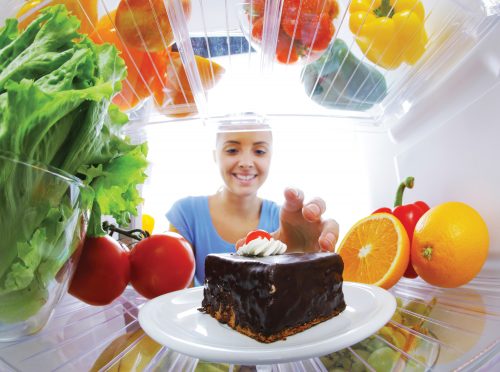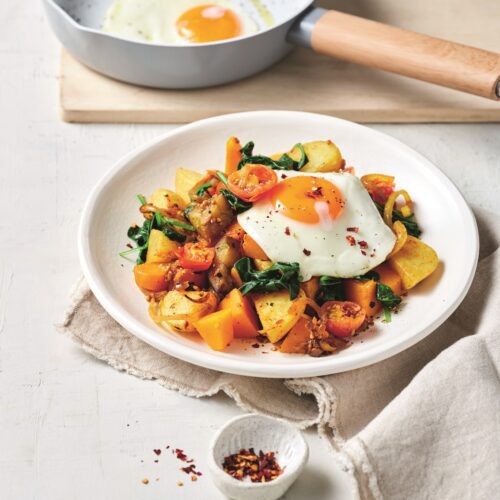
The surprising reasons why we accidentally overeat.
HFG nutritionist Claire Turnbull coaches us through the hidden traps in our eating environment — and how to beat them.
Stop for a minute and have a think about what you have eaten so far today. Maybe you had three meals like you always do? Perhaps you have just been picking and nibbling all day? While we all eat day-in day-out do you ever stop to think about why you eat what you do?
A lot of things influence what you eat and when: habits and routines, the people you live and work with, your likes and dislikes.
Our environment also has a great impact on our food choices. Once upon a time, shops were open for limited hours, takeaway stores were few and far between and a slice of cake was small and dainty. Now, we are surrounded by food, ‘buy one get one free’ deals and super-sizing galore! This is leading many of us to eat more than we need.
The trick is to see the environmental traps before you head towards them, and have strategies in place so you don’t get drawn into buying or eating more than you need.
Trap 1: ‘Value-for-money’ extras
Who doesn’t love a good deal? Food retailers know this and use value added extras to encourage you to buy more.
The deals on offer make it a ‘no brainer’ choice. If you get a coffee and then you are offered a muffin that’s normally $4.50 for $1.00 — it seems too good to turn down, right? Your brain says, ‘Of course, it makes sense’, but you are actually spending a dollar more than you planned to and, if you hadn’t intended to buy the muffin in the first place — it is more than you needed or wanted. You are being played.
I understand the temptation but there is a cost involved: your health and happiness, which is more valuable than anything else. If you feel guilty, sick or overfull after eating that $1.00 muffin — was it really good value? No. You have cheated yourself.
Strategy: Recognise the hidden cost of ‘value-added’ extras
- Manage your mind-set. Good value for money does have a ‘cost’ associated with it.
- Add it up and reap the reward. Over the year, add up how much money you have ‘saved’ from not going for the better value option (that you didn’t want or need in the first place) and buy yourself something that makes you feel healthy and happy — a massage or movie tickets.
Trap 2: Special deals
Buy one get one free. Two for the price of one. Up to 30 per cent off. You know the deals — they are everywhere from supermarkets to petrol stations.
If it’s a product you would normally buy and you actually need, great. But watch out for those deals which encourage you to buy something you didn’t plan to buy in the first place. These offers encourage you to step outside the decisions you would normally make and are likely to mean you eat food and drinks which you wouldn’t have ordinarily chosen — overriding your intentions and leading you off course, away from happy healthy living.
Research by Professor Brian Wansink at Cornell University has found that we struggle to refuse supermarket offers like ‘buy two, get one free’ and typically buy 30-100 per cent more. And we eat more when it’s stockpiled in our cupboards.
The hotel breakfast buffet, help-yourself style dinners and ‘all you can eat’ restaurants are another minefield. If breakfast is included in the cost of your stay, you feel as if you really need to get ‘value for money’ don’t you?
Recently someone shared a story with me about the time he and his son paid $25 a head for breakfast in a hotel. His son opted for a single slice of toast and an apple but he made his son go back and get more to eat because breakfast had cost him so much. Afterwards, he felt terrible and realised he was literally force feeding his son.
The ‘all you can eat’ situation is another time where the ‘deal’ can override your body’s natural hunger cues. You can end up overeating, feeling stuffed and uncomfortable: you have just hurt your body with food. This isn’t a great deal. It’s a kind of self-abuse. These environmental traps force us to override everything our body is trying to tell us.
Strategy: Determine if the offer is really that important
- Only go for deals on healthy foods which you actually need.
- Shop to a list and stick to it. If it’s not on your list, refer to the above tip, and only buy it if it’s a healthy food you want to eat.
- Don’t buy into ‘your money’s worth’. If you are staying at a hotel and breakfast is $25 and you feel like you will need to get your ‘money’s worth’ then choose not to play into the trap. Eat elsewhere.
Trap 3: Social situations
There is nothing like a social situation to encourage you to eat foods you ordinarily wouldn’t and to override your body’s messages to tell you that it is full. In many social situations you can find yourself eating food just because it is there, because everyone else is eating or just because you find that you can’t say no when someone offers you a slice of cake. Workplace morning tea shouts and birthday dos, pre-dinner nibbles and plane journeys where you are offered a cookie and coffee you don’t really want or need are prime examples when you end up eating for the wrong reasons.
Dinners out are another place we can be tricked into eating more. Professor Wansink’s research found that menu descriptions affect our choices. The research found more appetising names could increase sales by 23 per cent, as well as making people think the food tasted a lot better. And, perhaps unsurprisingly, drinks before dinner reduce our inhibitions, so we eat more than intended when enjoying a tipple.
Strategy: Be mentally prepared for the event
- Be aware of your situation. Before you head to a morning tea, drinks and nibbles or other social situation, think about the food that might be there and decide before you go if you really want to eat anything when you get there. For a morning tea, practise how you will politely say ‘no thanks’ to the cake if you really don’t want it (and remember if anyone has an issue it’s their issue, not yours). If it is an evening thing, have a healthy snack before you go so you don’t end up so hungry after one wine or beer that you demolish a plate of hot chips!
- On a plane, learn to say no: Try taking the drink and say ‘no thanks’ to the food if you are just eating it because everyone else is. Learning to say ‘no thanks’ is very powerful, so get practising!
- When eating out, ask questions about how items are prepared and don’t be fooled by ‘healthy’ sounding dishes which give you licence to eat freely.
- Try to stay tuned in to your body’s satiety signals and stop when you are satisfied.
Trap 4: Portion creep
How big are muffins these days? Café sandwiches look like doorstops, don’t they? And drinks sizes have grown, too.
When I go to my grannie’s house I love looking at her dinner plate and tea cups — it reminds me how ridiculous things have become and how our portions have got out of control.
Portions are massive in restaurants, cafés and pubs and sizes have also crept up in our own homes with bigger pots, pans, plate, bowls and wine glasses — we are serving ourselves more.
This means that the amount we end up eating is impacted more by what we visually think is normal than what our body actually needs. By the time many of us stop eating and allow our food to settle we will end up feeling ‘over-full’ rather than just satisfied and no longer hungry — this then becomes ‘normal’ and overfeeding ourselves becomes a daily habit.
Strategy: Monitor portion distortion
- Work out how much you need to eat before you start cooking. Figure out how many grams of meat you really need to cook, how many cups of rice you need and so on. Avoid cooking more than you need.
- If you are cooking extras for leftovers the next day, serve portions into plastic containers straight away so there’s no risk of eating the extras.
- Upsize your non-starchy vegetables. Aim for half your plate (two good handfuls) at dinner and ideally at lunch, too. This will allow you to downsize on other parts of your meal without feeling hungry.
- Downsize your plates, cups and glasses. This really can make a difference.
- Give yourself time after eating a meal before you decide if you need to eat anything else. Allow your body about 30 minutes to deal with the food you have already eaten.
- Remember: it’s not the last supper. You will eat again! There are other meals to come.
Trap 5: Availability
The location of your local supermarket, the number of takeaway shops you pass on your way home from work and the vicinity of a vege and fruit shop or farmers’ market will directly impact on what you actually end up eating.
If you have a prolific vegetable patch and spend more time at the garden shop or at farmers’ markets than in heavy traffic to and from work (passing at least six fast-food outlets on your way home), then it’s no surprise that you will probably be eating healthier than those who hardly ever see vegetables.
Your ability to influence the types of shops and food outlets in your area may be limited but being aware of your surroundings and finding a way to hunt out healthier places to shop can make a real difference.
Strategy: Eat well in your area
- Explore your options. We often shop where we have always shopped — so see if you can suss out any alternatives such as vegetable stores or markets.
- Get into growing your own. Make your home environment as healthy as you can. Even if you just start with some herbs, lettuce or spinach — just start somewhere.
- Resist temptation. If you always find yourself going into a particular dairy, ice-cream shop or bakery on your normal driving route, see if you can find a new route. The same goes if you are walking. If you smell a doughnut or that delicious fresh bread smell from a bakery, it draws you in and can make you feel hungry when you may not need to eat at all. Avoid heading straight into your biggest temptations.
- Look into buying your food online. The choice and variety available online may be greater than you can get near you and you might even save money.
Article sources and references
- Duffey KJ & Popkin BM. 2011. Energy density, portion size, and eating occasions: Contributions to increased energy intake in the United States, 1977-2006. PLoS Medicine 8: e1001050https://www.ncbi.nlm.nih.gov/pubmed/21738451
- Wansink B. 2004. Environmental factors that increase the food intake and consumption volume of unknowing consumers. Annual Reviews of Nutrition 24:455-79https://www.ncbi.nlm.nih.gov/pubmed/15189128
- Wansink B. 2007. Mindless eating: why we eat more than we think. Bantam Books: New Yorkhttp://www.brianwansink.com/uploads/6/0/2/8/60286459/chapter_1_-_mindless_eating_-_the_mindless_margin__brian_wansink_2006_.pdf
- Wansink B & Van Ittersum K. 2007. Portion size me: Downsizing our consumption norms. Journal of the American Dietetic Association doi: 10.1016/j.jada.2007.05.019https://www.researchgate.net/publication/6232375_Portion_Size_Me_Downsizing_Our_Consumption_Norms
www.healthyfood.com










